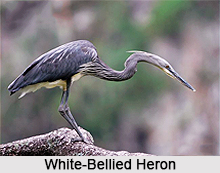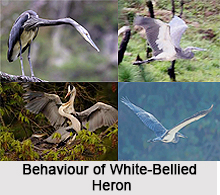 White-bellied heron is an Indian bird with a scientific name "Ardea insignis" that has a declining global population and it is enlisted in as Critically Endangered by the IUCN.
White-bellied heron is an Indian bird with a scientific name "Ardea insignis" that has a declining global population and it is enlisted in as Critically Endangered by the IUCN.
White-bellied heron also known as the imperial heron or great white-bellied heron, is a species of large heron found in the foothills of the eastern Indian Himalayas, which is also known as Shiwaliks Range, North Eastern Bangladesh, Burma and Bhutan.
White-bellied heron as an Endangered Species
White-bellied heron is mostly dark grey with a white throat and under parts. White-bellied heron is mostly solitary and is found on undisturbed riverside or wetland habitats. The global population has declined and the species is threatened by disturbance and habitat degradation. The species is currently listed as Critically Endangered by the IUCN.
History of White-Bellied Heron
White-bellied heron was first noted as the "great Indian heron" in JE Gray`s Zoological Miscellany of 1844 based on Brian Houghton Hodgson from Nepal. Allan Octavian Hume noted its distinctiveness and pointed out the differences between it and Ardea sumatrana. The alternate name of Ardea imperialis was suggested by Stuart Baker, since Hodgson`s name was a nomen nudum and this was used in Peters` check-list. This was used until 1963, when Biswamoy Biswas commented on Sidney Dillon Ripley`s synoptic list and noted that Ardea insignis Hume should be used, since its citation as a synonym of Ardea nobilis Blyth and Ardea sumatrana Raffles was based on misidentification.
Structure of White-Bellied Heron
White-bellied heron is a large heron that is plain dark grey in colour above a long neck. The crown is dark and there are no black stripes on the neck as in the grey heron. In breeding plumage, it has a greyish-white nape plume and elongated grey breast feathers with white centres. The bill is black, greenish near the base and tip and the face is greenish grey. The bill is large and solid, with the culmen measuring 15.2-17.6 cm (6.0-6.9 in). The chin and central portion of the underside are whitish in colour (per the common name), contrasting strongly against the dark grey colour on the back. The legs are blackish with scale-like texture on the tarsus which measures 17.1 to 21.6 cm (6.7 to 8.5 in). In flight, it has a uniform dark grey upper wing and white under wing-coverts contrasting with dark grey flight feathers. The rump appears paler grey. At 127 cm in height, it is the second largest heron on earth, after the Goliath heron. Included in the length, the mid-sized tail measures 19.9 to 21.6 cm (7.8 to 8.5 in). The wing chord measures 54.6 to 57.2 cm (21.5 to 22.5 in), with an estimated wingspan of 2 m (6.6 ft) or more. One estimate of body mass was relatively low at 2-2.6 kg (4.4-5.7 lb), however a deceased juvenile of the species reportedly weighed much more at 5.6 kg (12 lb). Another dead juvenile heron stood 1.58 m (5.2 ft) tall and weighed 8.51 kg (18.8 lb). These extremely high weights require verification, since they indicate this species can exceed even the typically larger Goliath heron in mass. On the ground it walks slowly, moving its neck slowly while looking from side to side. The Goliath species, beyond the average size difference, is distinguished by its chestnut neck while the slightly smaller great-billed heron is solid grey necked with the underside of the wings all grey.
The legs are blackish with scale-like texture on the tarsus which measures 17.1 to 21.6 cm (6.7 to 8.5 in). In flight, it has a uniform dark grey upper wing and white under wing-coverts contrasting with dark grey flight feathers. The rump appears paler grey. At 127 cm in height, it is the second largest heron on earth, after the Goliath heron. Included in the length, the mid-sized tail measures 19.9 to 21.6 cm (7.8 to 8.5 in). The wing chord measures 54.6 to 57.2 cm (21.5 to 22.5 in), with an estimated wingspan of 2 m (6.6 ft) or more. One estimate of body mass was relatively low at 2-2.6 kg (4.4-5.7 lb), however a deceased juvenile of the species reportedly weighed much more at 5.6 kg (12 lb). Another dead juvenile heron stood 1.58 m (5.2 ft) tall and weighed 8.51 kg (18.8 lb). These extremely high weights require verification, since they indicate this species can exceed even the typically larger Goliath heron in mass. On the ground it walks slowly, moving its neck slowly while looking from side to side. The Goliath species, beyond the average size difference, is distinguished by its chestnut neck while the slightly smaller great-billed heron is solid grey necked with the underside of the wings all grey.
Concentration of White-bellied heron
White-bellied heron is found in the wetlands of tropical and subtropical forests in the foothills of the eastern Himalayas of India and Myanmar. It also occurs in Bhutan`s sub-tropical areas and was once found in Nepal. In Bhutan, white-bellied herons are found along the Punatsang Chu river especially in Pho-chhu river banks in Toewang Gewog, along Kami Chhu river) and in Lower Kheng (Berti). It can also be found in Madgechhu (Trongsa). Another nesting site in India is the Namdapha National Park, Changlang District, Arunachal Pradesh and Tiger Reserve in Arunachal Pradesh.



















